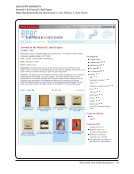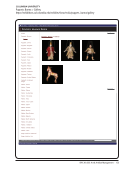60 · Survey Results: Survey Questions and Responses
constant temperature and humidity. Some of the art is on display throughout the library proper, thus are exposed to
light, etc., but many were donated or purchased for that purpose. Artifacts need better storage and more detailed
descriptions. My position, which was previously .25 FTE, was empty for six years. When I began, I was .20 FTE for ten
years, only becoming .4 FTE in the past three years. This position needs to be full-time.
The university archivist’s satisfaction with our strategies varies by material. She is satisfied with the management of
historic photographs and historic objects. She is less satisfied with the management of art. Fortunately, art represents a
very small proportion of holdings.
We also communicate with the museum staff at the university’s two other museums (art museum and world culture
museum) so whenever we’ve needed advice we have local expertise we can rely on.
We are just one year in to a campaign to provide adequate support for all types of collection in LCR, through centralized
metadata, system, and collection management support. Much of what we are doing is still learning.
We attempt NOT to collect 3-D artifacts, and yet, we keep getting them. They are useful in exhibits and do often
provide important historical or cultural information, but they come with many problems for a collection whose focus is
on 2-D documents!
We collaborate closely with the university art gallery. However, it is not always clear what objects should be a part of
their collection and what should remain a part of ours. The best example here would be cartoons. Both units collect
original cartoon art, but we treat them as part of an archival collection, they treat them as individual art objects. I would
also say that we actively collect artifacts for our history of plastics collection and hold to the belief that material culture
objects can be as valuable for research as written or printed materials.
We collect artists’ books (housed in Special Collections), and although these could be considered “art objects,” we
catalog them and treat them as books. I will provide the link to the section of the Fine Arts collection development
policy that deals with artists’ books.
We do not actively collection art and artifacts and make a strong effort to find other homes for these materials or
suggest to donors where these materials could be better housed, i.e., museum or historical society.
We do not currently have a standard. It has been left up to the person entering the data to come up with it. We are
moving toward using our university library’s data dictionary which pulls metadata from the Library of Congress and
other places, but this will happen slowly, and as we are able to digitize and provide online access to these materials.
With new leadership and a new structure, we are just beginning to put a plan for these materials in place.
With the exception of photographs and posters, we do not actively collect art and artifacts. We receive them through
donations.
constant temperature and humidity. Some of the art is on display throughout the library proper, thus are exposed to
light, etc., but many were donated or purchased for that purpose. Artifacts need better storage and more detailed
descriptions. My position, which was previously .25 FTE, was empty for six years. When I began, I was .20 FTE for ten
years, only becoming .4 FTE in the past three years. This position needs to be full-time.
The university archivist’s satisfaction with our strategies varies by material. She is satisfied with the management of
historic photographs and historic objects. She is less satisfied with the management of art. Fortunately, art represents a
very small proportion of holdings.
We also communicate with the museum staff at the university’s two other museums (art museum and world culture
museum) so whenever we’ve needed advice we have local expertise we can rely on.
We are just one year in to a campaign to provide adequate support for all types of collection in LCR, through centralized
metadata, system, and collection management support. Much of what we are doing is still learning.
We attempt NOT to collect 3-D artifacts, and yet, we keep getting them. They are useful in exhibits and do often
provide important historical or cultural information, but they come with many problems for a collection whose focus is
on 2-D documents!
We collaborate closely with the university art gallery. However, it is not always clear what objects should be a part of
their collection and what should remain a part of ours. The best example here would be cartoons. Both units collect
original cartoon art, but we treat them as part of an archival collection, they treat them as individual art objects. I would
also say that we actively collect artifacts for our history of plastics collection and hold to the belief that material culture
objects can be as valuable for research as written or printed materials.
We collect artists’ books (housed in Special Collections), and although these could be considered “art objects,” we
catalog them and treat them as books. I will provide the link to the section of the Fine Arts collection development
policy that deals with artists’ books.
We do not actively collection art and artifacts and make a strong effort to find other homes for these materials or
suggest to donors where these materials could be better housed, i.e., museum or historical society.
We do not currently have a standard. It has been left up to the person entering the data to come up with it. We are
moving toward using our university library’s data dictionary which pulls metadata from the Library of Congress and
other places, but this will happen slowly, and as we are able to digitize and provide online access to these materials.
With new leadership and a new structure, we are just beginning to put a plan for these materials in place.
With the exception of photographs and posters, we do not actively collect art and artifacts. We receive them through
donations.


















































































































































































